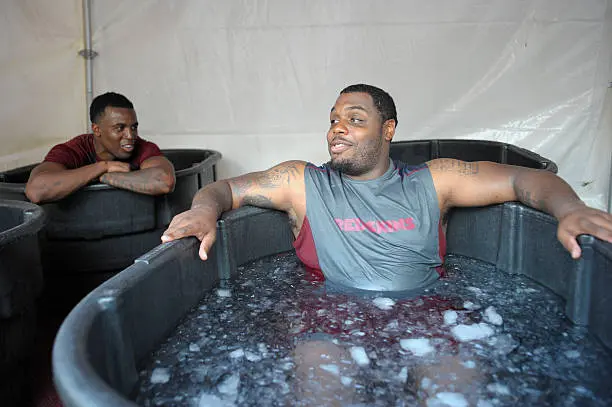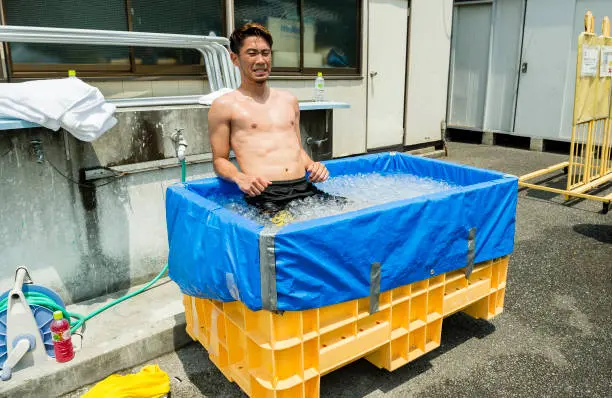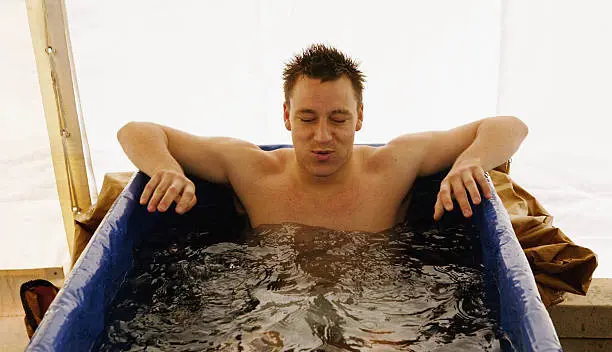Why do Basketball Players Take Ice Baths?
Across the NBA and the varying amateur and professional sports leagues in the country, athletes are deluging themselves in buckets of ice cold water. Often seen immediately after the end of a game, these athletes withstand frigid temperatures to better enhance their recovery and readiness for the next game.
But just why do basketball and NBA players take ice baths and do these ice baths help an athlete to perform better?
Below, we are going to do a deep dive into just whether or not ice baths can help basketball players, and athletes in general, recover after a particularly brutal or difficult game and whether or not you should consider beginning the routine yourself.

What is an Ice Bath?
As the name suggests, an ice bath is an immersion in ice cold water. Typically done in a tub or container large enough to fit an individual up to their waist, the tub or container will be filled with ice cold water with an additional amount of ice added to the water.
Typically, most athletes and participants of an ice bath prefer to have the water temperature range from 50-59 degrees Fahrenheit. And while many assume that the colder the water the better, that is not necessarily true.
Rather, experts suggest that the 50-59 degree Fahrenheit range is ideal and that going any lower can begin to have negative effects on ones health and recovery.
As such, if you plan to begin partaking in an ice bath, be sure to have a thermometer on hand. You should always measure the temperature of the water before diving in to ensure that the temperature range is within the recommended levels.

When do Athletes and Basketball Players Take an Ice Bath?
Ideally, basketball players, and athletes in general, should try to take an ice bath immediately after the end of a particularly grueling or difficult practice, workout, or game, even before giving their respective post-game interviews. That is, before your body cools down and relaxes from the end of a practice, workout, or game, you should jump into an ice bath.
The belief for doing so is that due to the exertion placed on the muscles and the body, immediately jumping into an ice bath can more quickly assist in the recovery process and allow for sore muscles and joints to begin healing.
How Long do Basketball Players Take an Ice Bath For?
Contrary to popular belief, ice baths do not need to be extended past 10 minutes in total length of time. However, there really is no ideal amount of time or recommended one. Rather, if you are looking to begin taking an ice bath after your workouts or games, do so for as long as you feel comfortable and able to.
That is, if you begin to feel overwhelmed by the sensation and frigidity, then feel free to hop out. As a beginner, look to slowly increase the amount of time that you spend in an ice bath. While in the beginning you may only be able to stay in the water for a minute or two, you can slowly work your way up to ten minutes.

What Does an Ice Bath Feel Like?
A common question we’re often asked is, just what does an ice bath feel like?
And honestly, at first, the feeling is one of agony. The rush of the cold water against your body feels almost indescribable and can really just be almost a level of pure pain. This is especially true if you jump in after a workout or game and are still dripping with sweat.
The cold water and beads of ice splashing and jagging against your skin does not feel great and almost feels like a shock to your system. However, after about 30-60 seconds, your body begins to acclimate to the cold water and you begin to feel a bit numb to it.
That’s not to say that you don’t feel the cold, it just becomes more bearable and your body acclimates to it. Believe me, it’s still cold, but your body adapts rather quickly and the shock begins to wear off after 30-60 seconds once immersed in the water.

What Are the Benefits and Disadvantages to Taking an Ice Bath?
While the benefits of ice baths are extolled by players, coaches, and trainers across the wide spectrum of the sporting world, it’s important to take any virtues with a grain of salt. That’s not to say that there aren’t benefits to an ice bath, but it is to say that many of the claims may be over-reported and may simply be a placebo effect.
Notwithstanding, there have been some clinical studies done which looked into the benefits of an ice bath on an athlete. Below, we will list the findings of these clinical studies. These findings points to both benefits and disadvantages of partaking in the practice and do not include our own anecdotal experience.
Benefits of an Ice Bath for Basketball Players
- Water immersion may cause physiological changes in the body, such as intracellular–intravascular fluid shift, reduction of muscle edema as well as increased cardiac output helping with enhanced blood flow, nutrient distribution and waste transportation.
- Water immersion may also be an added psychological benefit, whereby there is a reduction of the feeling of fatigue during immersion.
- Water immersion is also helpful in reducing exercise-induced increase in muscle volume and also reducing soft tissue inflammation.
- Water immersion appears to affect a similar physiological response to active recovery without the need to expend extra energy. The cardiac output increases in relation to the depth of immersion and has been observed to increase by as much as 102% during head-out immersions. These cardiovascular responses occur without any increase in energy expenditure. In simpler words, water immersion can help hasten recovery without having to expend energy to recover. Due to the increased water pressure against the muscles, your body is able to begin recovery without having to actively work on recovering.
- Lactate production, which is done when the body breaks down carbohydrates to use for energy when oxygen levels are low, was hastened with the introduction of ice bath immersion and that water immersion therapy is a valid method of hastening the decrease in lactate levels during recovery.
Disadvantages of an Ice Bath for Basketball Players
- One study found that the benefits of ice baths were transient and temporary and that by cooling the body by force, it reduces temperature specific and dependent processes in a negative manner.
- Another study tested athletes in two groups, one group who partook in an ice bath therapy and another who did not. In the study, researchers concluded that ice bath therapy was ineffective in minimizing muscle soreness.
- In another study on cyclists, researchers found that ice bath immersion can have negative physiological effects and can impair performance in future cycling performances.

Should You Begin Taking Ice Baths?
Ice baths, as with so many other novel and unique training and recovery methodologies utilizes by athletes, is still in its infancy. And while studies are inconclusive as to whether or not the technique is beneficial or not, there does not appear to be long-term negative health consequences to engaging in the therapy.
Deciding on whether or not to begin an ice bath therapy is, therefore, a personal choice. If you feel comfortable doing so, then there does not appear to be too many negative side-effects and the simple psychological benefits of doing so may be worth the effort.
However, as an alternative to an ice bath therapy, basketball players and athletes can consider some of the following post-workout recovery methods.
- Sufficient rest to allow for natural recovery to occur
- Gentle stretching that helps the muscle to recover faster
- A proper balanced diet to aid in muscle recovery
- Adequate fluid replacement, including drinking copious amounts of water and electrolytes
- A massage which targets sore muscles and affected areas of the body
